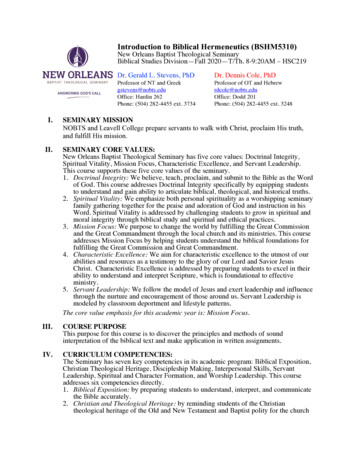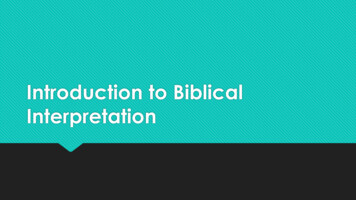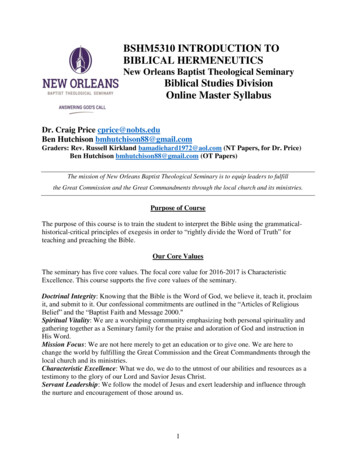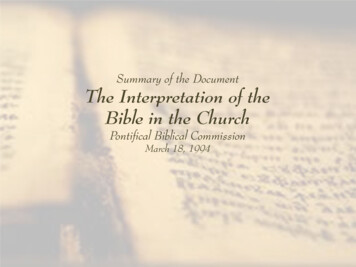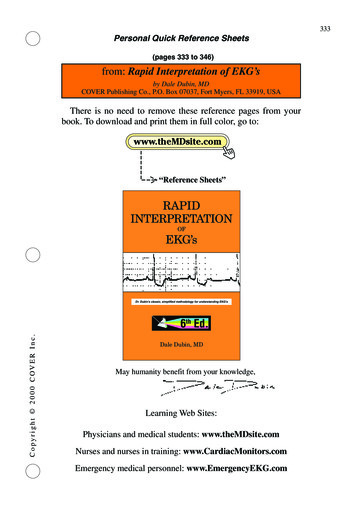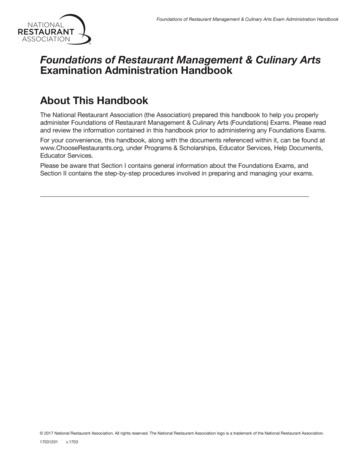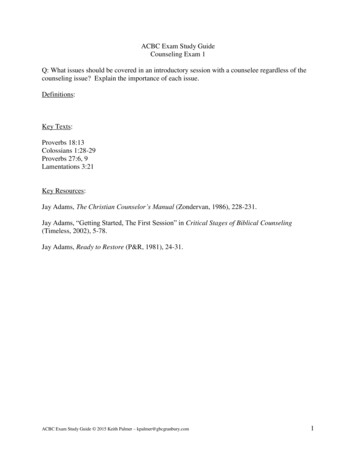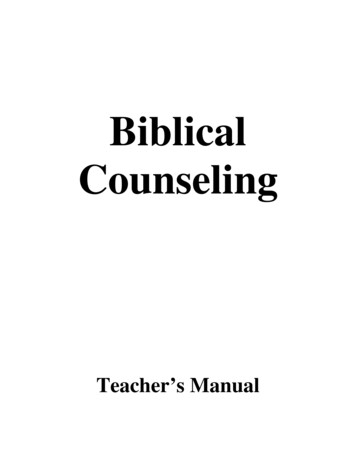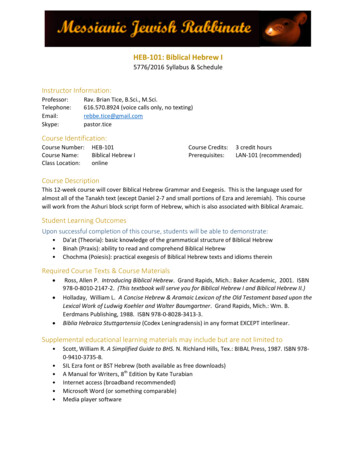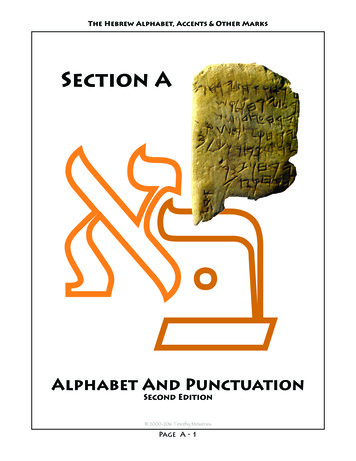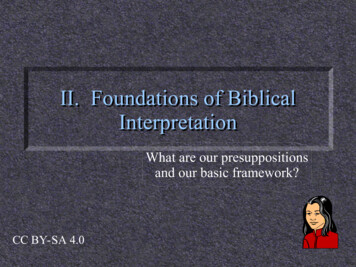
Transcription
II. Foundations of BiblicalInterpretationWhat are our presuppositionsand our basic framework?CC BY-SA 4.0
Unless otherwise indicated, all English Scripturequotations are from the ESV Bible (The HolyBible, English Standard Version ), copyright 2001 by Crossway, a publishing ministry of GoodNews Publishers. Used by permission. All rightsreserved.Permission to reuse this file is granted underCreative Commons Attribution-ShareAlike 4.0International: CC BY-SA 4.0. In addition,permission is given under GNU FreeDocumentation License, reproduced onsubsequent pages.
Copyright SpecificationsCopyright (c) 2006 Vern S. Poythress.Permission is granted to copy, distribute and/or modify this documentunder the terms of the GNU Free Documentation License, Version 1.2 orany later version published by the Free Software Foundation; with noInvariant Sections, no Front-Cover Texts, and no Back-Cover Texts. Acopy of the license is included in the next slides and at http://www.fsf.org/licensing/licenses/fdl.html .The clipart embedded within the slides is from various sources, primarily from MS Officeclipart gallery, Corel Clip-Art from CD-ROM Clipart, Symbols & Flics, which was part ofCorel Draw 3.0, and Corel Megagallery, which came with Corel Draw 8. I have tried to makesure that the clipart can be freely copied and modified, but it is not itself subject to the GNUFree Documentation License. Likewise photos are from various sources, primarily CorelMegagallery. Except when the photos are my own, they are not subject to the GNU FreeDocumentation License.
GNU Free Documentation LicenseVersion 1.2, November 2002Copyright (C) 2000,2001,2002 Free Software Foundation, Inc.51 Franklin Street, Fifth Floor, Boston, MA 02110-1301, USAEveryone is permitted to copy and distribute verbatim copiesof this license document, but changing it is not allowed.0. PREAMBLEThe purpose of this License is to make a manual, textbook, or other functional and useful document "free" in the sense of freedom: to assure everyonethe effective freedom to copy and redistribute it, with or without modifying it, either commercially or noncommercially. Secondarily, this Licensepreserves for the author and publisher a way to get credit for their work, while not being considered responsible for modifications made by others.This License is a kind of "copyleft", which means that derivative works of the document must themselves be free in the same sense. It complements theGNU General Public License, which is a copyleft license designed for free software.We have designed this License in order to use it for manuals for free software, because free software needs free documentation: a free program shouldcome with manuals providing the same freedoms that the software does. But this License is not limited to software manuals; it can be used for anytextual work, regardless of subject matter or whether it is published as a printed book. We recommend this License principally for works whose purposeis instruction or reference.1. APPLICABILITY AND DEFINITIONSThis License applies to any manual or other work, in any medium, that contains a notice placed by the copyright holder saying it can be distributedunder the terms of this License. Such a notice grants a world-wide, royalty-free license, unlimited in duration, to use that work under the conditionsstated herein. The "Document", below, refers to any such manual or work. Any member of the public is a licensee, and is addressed as "you". Youaccept the license if you copy, modify or distribute the work in a way requiring permission under copyright law.A "Modified Version" of the Document means any work containing the Document or a portion of it, either copied verbatim, or with modificationsand/or translated into another language.A "Secondary Section" is a named appendix or a front-matter section of the Document that deals exclusively with the relationship of the publishers orauthors of the Document to the Document's overall subject (or to related matters) and contains nothing that could fall directly within that overallsubject. (Thus, if the Document is in part a textbook of mathematics, a Secondary Section may not explain any mathematics.) The relationship could bea matter of historical connection with the subject or with related matters, or of legal, commercial, philosophical, ethical or political position regardingthem.
The "Invariant Sections" are certain Secondary Sections whose titles are designated, as being those of Invariant Sections, in the notice that says that theDocument is released under this License. If a section does not fit the above definition of Secondary then it is not allowed to be designated as Invariant.The Document may contain zero Invariant Sections. If the Document does not identify any Invariant Sections then there are none.The "Cover Texts" are certain short passages of text that are listed, as Front-Cover Texts or Back-Cover Texts, in the notice that says that the Documentis released under this License. A Front-Cover Text may be at most 5 words, and a Back-Cover Text may be at most 25 words.A "Transparent" copy of the Document means a machine-readable copy, represented in a format whose specification is available to the general public,that is suitable for revising the document straightforwardly with generic text editors or (for images composed of pixels) generic paint programs or (fordrawings) some widely available drawing editor, and that is suitable for input to text formatters or for automatic translation to a variety of formatssuitable for input to text formatters. A copy made in an otherwise Transparent file format whose markup, or absence of markup, has been arranged tothwart or discourage subsequent modification by readers is not Transparent. An image format is not Transparent if used for any substantial amount oftext. A copy that is not "Transparent" is called "Opaque".Examples of suitable formats for Transparent copies include plain ASCII without markup, Texinfo input format, LaTeX input format, SGML or XMLusing a publicly available DTD, and standard-conforming simple HTML, PostScript or PDF designed for human modification. Examples of transparentimage formats include PNG, XCF and JPG. Opaque formats include proprietary formats that can be read and edited only by proprietary wordprocessors, SGML or XML for which the DTD and/or processing tools are not generally available, and the machine-generated HTML, PostScript orPDF produced by some word processors for output purposes only.The "Title Page" means, for a printed book, the title page itself, plus such following pages as are needed to hold, legibly, the material this Licenserequires to appear in the title page. For works in formats which do not have any title page as such, "Title Page" means the text near the most prominentappearance of the work's title, preceding the beginning of the body of the text.A section "Entitled XYZ" means a named subunit of the Document whose title either is precisely XYZ or contains XYZ in parentheses following textthat translates XYZ in another language. (Here XYZ stands for a specific section name mentioned below, such as "Acknowledgements", "Dedications","Endorsements", or "History".) To "Preserve the Title" of such a section when you modify the Document means that it remains a section "EntitledXYZ" according to this definition.The Document may include Warranty Disclaimers next to the notice which states that this License applies to the Document. These WarrantyDisclaimers are considered to be included by reference in this License, but only as regards disclaiming warranties: any other implication that theseWarranty Disclaimers may have is void and has no effect on the meaning of this License.2. VERBATIM COPYINGYou may copy and distribute the Document in any medium, either commercially or noncommercially, provided that this License, the copyright notices,and the license notice saying this License applies to the Document are reproduced in all copies, and that you add no other conditions whatsoever tothose of this License. You may not use technical measures to obstruct or control the reading or further copying of the copies you make or distribute.However, you may accept compensation in exchange for copies. If you distribute a large enough number of copies you must also follow the conditionsin section 3.You may also lend copies, under the same conditions stated above, and you may publicly display copies.
3. COPYING IN QUANTITYIf you publish printed copies (or copies in media that commonly have printed covers) of the Document, numbering more than 100, and the Document'slicense notice requires Cover Texts, you must enclose the copies in covers that carry, clearly and legibly, all these Cover Texts: Front-Cover Texts onthe front cover, and Back-Cover Texts on the back cover. Both covers must also clearly and legibly identify you as the publisher of these copies. Thefront cover must present the full title with all words of the title equally prominent and visible. You may add other material on the covers in addition.Copying with changes limited to the covers, as long as they preserve the title of the Document and satisfy these conditions, can be treated as verbatimcopying in other respects.If the required texts for either cover are too voluminous to fit legibly, you should put the first ones listed (as many as fit reasonably) on the actual cover,and continue the rest onto adjacent pages.If you publish or distribute Opaque copies of the Document numbering more than 100, you must either include a machine-readable Transparent copyalong with each Opaque copy, or state in or with each Opaque copy a computer-network location from which the general network-using public hasaccess to download using public-standard network protocols a complete Transparent copy of the Document, free of added material. If you use the latteroption, you must take reasonably prudent steps, when you begin distribution of Opaque copies in quantity, to ensure that this Transparent copy willremain thus accessible at the stated location until at least one year after the last time you distribute an Opaque copy (directly or through your agents orretailers) of that edition to the public.It is requested, but not required, that you contact the authors of the Document well before redistributing any large number of copies, to give them achance to provide you with an updated version of the Document.4. MODIFICATIONSYou may copy and distribute a Modified Version of the Document under the conditions of sections 2 and 3 above, provided that you release theModified Version under precisely this License, with the Modified Version filling the role of the Document, thus licensing distribution and modificationof the Modified Version to whoever possesses a copy of it. In addition, you must do these things in the Modified Version:* A. Use in the Title Page (and on the covers, if any) a title distinct from that of the Document, and from those of previous versions (which should, ifthere were any, be listed in the History section of the Document). You may use the same title as a previous version if the original publisher of thatversion gives permission.* B. List on the Title Page, as authors, one or more persons or entities responsible for authorship of the modifications in the Modified Version,together with at least five of the principal authors of the Document (all of its principal authors, if it has fewer than five), unless they release you fromthis requirement.* C. State on the Title page the name of the publisher of the Modified Version, as the publisher.* D. Preserve all the copyright notices of the Document.* E. Add an appropriate copyright notice for your modifications adjacent to the other copyright notices.
* F. Include, immediately after the copyright notices, a license notice giving the public permission to use the Modified Version under the terms of thisLicense, in the form shown in the Addendum below.* G. Preserve in that license notice the full lists of Invariant Sections and required Cover Texts given in the Document's license notice.* H. Include an unaltered copy of this License.* I. Preserve the section Entitled "History", Preserve its Title, and add to it an item stating at least the title, year, new authors, and publisher of theModified Version as given on the Title Page. If there is no section Entitled "History" in the Document, create one stating the title, year, authors, andpublisher of the Document as given on its Title Page, then add an item describing the Modified Version as stated in the previous sentence.* J. Preserve the network location, if any, given in the Document for public access to a Transparent copy of the Document, and likewise the networklocations given in the Document for previous versions it was based on. These may be placed in the "History" section. You may omit a network locationfor a work that was published at least four years before the Document itself, or if the original publisher of the version it refers to gives permission.* K. For any section Entitled "Acknowledgements" or "Dedications", Preserve the Title of the section, and preserve in the section all the substanceand tone of each of the contributor acknowledgements and/or dedications given therein.* L. Preserve all the Invariant Sections of the Document, unaltered in their text and in their titles. Section numbers or the equivalent are notconsidered part of the section titles.* M. Delete any section Entitled "Endorsements". Such a section may not be included in the Modified Version.* N. Do not retitle any existing section to be Entitled "Endorsements" or to conflict in title with any Invariant Section.* O. Preserve any Warranty Disclaimers.If the Modified Version includes new front-matter sections or appendices that qualify as Secondary Sections and contain no material copied from theDocument, you may at your option designate some or all of these sections as invariant. To do this, add their titles to the list of Invariant Sections in theModified Version's license notice. These titles must be distinct from any other section titles.You may add a section Entitled "Endorsements", provided it contains nothing but endorsements of your Modified Version by various parties--forexample, statements of peer review or that the text has been approved by an organization as the authoritative definition of a standard.You may add a passage of up to five words as a Front-Cover Text, and a passage of up to 25 words as a Back-Cover Text, to the end of the list of CoverTexts in the Modified Version. Only one passage of Front-Cover Text and one of Back-Cover Text may be added by (or through arrangements madeby) any one entity. If the Document already includes a cover text for the same cover, previously added by you or by arrangement made by the sameentity you are acting on behalf of, you may not add another; but you may replace the old one, on explicit permission from the previous publisher thatadded the old one.
The author(s) and publisher(s) of the Document do not by this License give permission to use their names for publicity for or to assert or implyendorsement of any Modified Version.5. COMBINING DOCUMENTSYou may combine the Document with other documents released under this License, under the terms defined in section 4 above for modified versions,provided that you include in the combination all of the Invariant Sections of all of the original documents, unmodified, and list them all as InvariantSections of your combined work in its license notice, and that you preserve all their Warranty Disclaimers.The combined work need only contain one copy of this License, and multiple identical Invariant Sections may be replaced with a single copy. If thereare multiple Invariant Sections with the same name but different contents, make the title of each such section unique by adding at the end of it, inparentheses, the name of the original author or publisher of that section if known, or else a unique number. Make the same adjustment to the sectiontitles in the list of Invariant Sections in the license notice of the combined work.In the combination, you must combine any sections Entitled "History" in the various original documents, forming one section Entitled "History";likewise combine any sections Entitled "Acknowledgements", and any sections Entitled "Dedications". You must delete all sections Entitled"Endorsements."6. COLLECTIONS OF DOCUMENTSYou may make a collection consisting of the Document and other documents released under this License, and replace the individual copies of thisLicense in the various documents with a single copy that is included in the collection, provided that you follow the rules of this License for verbatimcopying of each of the documents in all other respects.You may extract a single document from such a collection, and distribute it individually under this License, provided you insert a copy of this Licenseinto the extracted document, and follow this License in all other respects regarding verbatim copying of that document.7. AGGREGATION WITH INDEPENDENT WORKSA compilation of the Document or its derivatives with other separate and independent documents or works, in or on a volume of a storage ordistribution medium, is called an "aggregate" if the copyright resulting from the compilation is not used to limit the legal rights of the compilation'susers beyond what the individual works permit. When the Document is included in an aggregate, this License does not apply to the other works in theaggregate which are not themselves derivative works of the Document.If the Cover Text requirement of section 3 is applicable to these copies of the Document, then if the Document is less than one half of the entireaggregate, the Document's Cover Texts may be placed on covers that bracket the Document within the aggregate, or the electronic equivalent of coversif the Document is in electronic form. Otherwise they must appear on printed covers that bracket the whole aggregate.
8. TRANSLATIONTranslation is considered a kind of modification, so you may distribute translations of the Document under the terms of section 4. Replacing InvariantSections with translations requires special permission from their copyright holders, but you may include translations of some or all Invariant Sections inaddition to the original versions of these Invariant Sections. You may include a translation of this License, and all the license notices in the Document,and any Warranty Disclaimers, provided that you also include the original English version of this License and the original versions of those notices anddisclaimers. In case of a disagreement between the translation and the original version of this License or a notice or disclaimer, the original version willprevail.If a section in the Document is Entitled "Acknowledgements", "Dedications", or "History", the requirement (section 4) to Preserve its Title (section 1)will typically require changing the actual title.9. TERMINATIONYou may not copy, modify, sublicense, or distribute the Document except as expressly provided for under this License. Any other attempt to copy,modify, sublicense or distribute the Document is void, and will automatically terminate your rights under this License. However, parties who havereceived copies, or rights, from you under this License will not have their licenses terminated so long as such parties remain in full compliance.10. FUTURE REVISIONS OF THIS LICENSEThe Free Software Foundation may publish new, revised versions of the GNU Free Documentation License from time to time. Such new versions willbe similar in spirit to the present version, but may differ in detail to address new problems or concerns. See http://www.gnu.org/copyleft/.Each version of the License is given a distinguishing version number. If the Document specifies that a particular numbered version of this License "orany later version" applies to it, you have the option of following the terms and conditions either of that specified version or of any later version that hasbeen published (not as a draft) by the Free Software Foundation. If the Document does not specify a version number of this License, you may chooseany version ever published (not as a draft) by the Free Software Foundation.
The ChallengeSo where do youget your ideas forhow to interpret?The Bible itself hasmuch to say about it.
Reading Assignments Required:– Poythress, "Introducing Lex Christi."– Berkhof, Principles of Biblical Interpretation11-39 (history of interpretation)– Poythress, God-Centered Biblical Interpretation(foundations) Optional:– Berkhof, Principles 40-60 (inspiration)– Van Til, An Introduction to SystematicTheology 62-158, especially 110-145.
Where Are We? I. Course arrangements II. Foundations of biblical interpretation III. Basic steps in biblical interpretation Elaborating on the steps: Looking at principles and framework
Where Are We? I. Course arrangements II. Foundations of biblical interpretation III. Basic steps in biblical interpretation Elaborating on the steps: Let’s look at the principles and frameworkfor biblical interpretation.
0. Introducing Lex Christi
Use of Lex Christi Ten Commandments as perspectives ontheology and biblical interpretation Useful as a cross-cultural teachingframework 4C, as focusing on dynamic, or process Interpretation is a process, normed byScripture (lex)
A. Legitimacy of BiblicalInterpretation
1. Is There a Problem?
Does the Bible NeedInterpretation? Hermeneutics how to study the Bible.But if the Bible is sufficient,do we need method?So why have a class?
Does the Bible NeedInterpretation? Hermeneutics how to study the Bible.But if the Bible is sufficient, why useany study techniques at all? Aren’t weundermining the Holy Spirit?So why have a class?
2. Biblical Mandate forBiblical Interpretation
The Gift of Teaching The Bible speaks of teachers and teaching(1 Cor. 12:28; Eph. 4:11; Rom. 12:7).Interpretfor others
Christ InterpretsLuke 24:25-27: (27)And beginning withMoses and all the Prophets, he interpretedto them in all the Scriptures the thingsconcerning himself.27b: διερμήνευσεν αὐτοῖς ἐν πάσαιςταῖς γραφαῖς τὰ περὶ ἑαυτοῦ.
Christ InterpretsLuke 24:25-27: And he said to them, “O foolishones, and slow of heart to believe all that theprophets have spoken! (26)Was it not necessary thatthe Christ should suffer these things and enter intohis glory?” (27)And beginning with Moses and allthe Prophets, he interpreted to them in all theScriptures the things concerning himself.27b: διερμήνευσεν αὐτοῖς ἐν πάσαις ταῖςγραφαῖς τὰ περὶ ἑαυτοῦ.
Christ Interprets MoreLuke 24:45: Then he opened their minds tounderstand the Scriptures.τότε διήνοιξεν αὐτῶν τὸν νοῦν τοῦσυνιέναι τὰς γραφάς·
The Holy Spirit InterpretsJohn 16:13: When the Spirit of truthcomes, he will guide (ὁδηγήσει) you intoall the truth. “Guiding” is a hermeneutical function.
Spirit Motivates Effort The Spirit motivates effort, not relaxation.Acts 8:26-40 (Philip and the Ethiopian)Phil 2:12-13: work out your own salvationwith fear and trembling, for it is God whoworks in you, both to will and to work forhis good pleasure.Godyou
Spirit Motivates Effort The Spirit motivates human effort ratherthan leading to quietism.Acts 8:26-40 (Philip and the Ethiopian)Phil 2:12-13: Therefore, my beloved, as you havealways obeyed, so now, not only as in my presencebut much more in my absence, work out your ownsalvation with fear and trembling, 2:13 for it is Godwho works in you, both to will and to work for hisgood pleasure.
Translation RequiresInterpretation The gospel goes to all nations (Acts). Translation to new languages requiresinterpretation.Missionary mandateTranslationTranslationGod's plan implicitlyincludes interpretation.
Translation RequiresInterpretation Acts endorses the spread of the gospel to allnations. Translation and the spread of the gospel tonew linguistic groups requiresinterpretation.God's plan implicitlyincludes interpretation.
Some Things are Difficult2 Pet. 3:16: There are some things in them[Paul’s letters] that are hard to understand(δυσνόητά τινα), . The subject-matter is intrinsically difficult.
Some Things are Difficult2 Pet. 3:16: There are some things in them[Paul’s letters] that are hard to understand(δυσνόητά τινα), which the ignorant andunstable twist to their own destruction, asthey do the other Scriptures. The subject-matter is intrinsically difficult.
We May Be DullLuke 24:25: O foolish ones, and slow ofheart to believe all that the prophets havespoken Have you everfelt this way?
Positive Role of the Mind The mind is not intrinsically unspiritual(Matt. 22:37; Eph. 4:17-24; Rom. 12:1-2). Tension between mind and Spirit comesfrom a crippled view. The Holy Spirit created the mind (Gen. 1:2;Ps. 104:30; Job 32:8). Redemption destroys sin, not creation.
Positive Role of the Mind The mind is not intrinsically unspiritual(Matt. 22:37; Eph. 4:17-24; Rom. 12:1-2). Supposed tension between mind and Spiritcomes from a crippled view. The Holy Spirit is the Creator of all (Gen.1:2; Ps. 104:30; Job 32:8), including mind. Redemption does not destroy creation butdestroys sin, the perversion of creation.
Pride Corrupts the MindIntelligent, informedpeople don't believethat kids' stuff.Look how spiritualI am in not usingmy mind!
3. Clarity of Scripture
Meaning of Clarity The Bible’s basic message is clear. But naive reading can make mistakes.For example:– Pharisee and tax collector(Luke 18:9-14).– The banquet (Luke 14:15-24).Not everythingis obvious.
Meaning of Clarity The Bible’s basic message is clear andaccessible to all. But sincere, naïve first reading can makemistakes. For example:Not everything– Identifying with the taxis obvious.collector in Luke 18:9-14.– The banquet in Luke 14:15-24.
4. Nonreflection Does NotEliminate Bias Biases exist unawares. Reflection can create further biases, butcan also eliminate biases. Hermeneutics arises to solve problems.
4. Nonreflection Does NotEliminate Bias Biases exist even when we are not awareof them. Reflection can create further biases, butcan also eliminate biases. Hermeneutics does not create theproblem, but arises when people alreadyhave a problem.
Implications of Lex Christi1C: God is Lord of all.7C: God is present in every aspect of life.Together, these imply that we should applyourselves comprehensively to reform theway we respond to Scripture.
B. The Interpretive FrameworkProvided by a Biblical Worldview
Lex Christi Framework From 1C: God is all-important 2C: Covenantal words are from God,through speech, to man 1C: God is God 2C: God specifies his covenant 3C: Man receives under obligation
1. Lordship of God God is absolute Lord of all. We owe absolute allegiance, in all things.– Matt. 22:37: “You shall love the Lord your Godwith all your heart and with all your soul andwith all your mind.”– 2 Cor. 10:4-5: We destroy arguments and everylofty opinion raised against the knowledge ofGod, and take every thought captive to obeyChrist.
2. Biblical Worldview
Creator/Creature Distinction Listen; don’t imposeGodNO to: Pantheistic mysticism Platonic reminiscenceMan RationalismThe doctrine of God Autonomous hermeneuticsmakes a difference!
Immanence of God God meets us where we are. Interpretation is fruitful.We are goingsomewhere.
Immanence of God God meets us where we are. Interpretation is not hopeless, groping foran inexpressible something, but fruitfulbecause God provides.We are goingsomewhere.
God Plans History Interpretation has a goal. We are responsible to God for interpreting.CreationHistoryConsummation
God Designs HumanRelationships We depend on others.GodNot a threat,but as aspectof God's plan.
God Designs HumanRelationships We are dependent on God and on otherhuman beings, but not so as to be puppets.GodNot a threat,but as aspectof God's plan.
3. The Word of God
What Is the Word of God? The Bible is the word of God. The word of God is what God says; it isGod speaking.I am the Lord your God,who brought you outof the land of Egypt
Forms of the Word of God The eternal word (John 1:1) God speaks to us (covenantal; Heb. 1:1-3)– Direct address– Divine messengers– Written word– Incarnate Christ God speaks to the world (Pss. 33:6; 147:18;etc.)
4. Functions of God’s Word
Covenantal Words 2 Cor. 3 uses covenant for Moses and Paul. Covenant is a perspective on all. Ancient treaties offer an analogue.
Covenantal Words 2 Cor. 3 sees Mosaic words and gospel ascovenantal. Covenant can be used as a perspective onall God’s communication. In the Ancient Near East, treaties betweensuzerain and vassal offer an analogue.
Analogy with Treaty Hittite suzerainty treaties had five parts:– Identification of suzerain: “I am the Lord”– Historical prologue: “who brought you out”– Stipulations: “You shall have no other gods”– Sanctions: “the Lord will not hold himguiltless”– Passing on: Deut. 31-32.
Generalizing Three AspectsNormativity: meaningfuldirection (stipulations)Control: binding(prologue, sanctions)Presence: dwelling(identity, passing on)
Dependence on God Three aspects interlock. No scientifically isolated “meaning” (todominate interpretation). No isolated mysticism (without rationalobedience).
Dependence on God Three aspects interlock. We cannot isolate “meaning” (normative)in order scientifically to dominateinterpretation. We cannot isolate presence in ordermystically to commune withoutresponsible obedience.
5. Human Nature
Creation of Man Image of God (Gen 1:26-28) Intrinsically imitative of God in knowledge Capable of understanding God's word
Kinds of Human Nature
The "Invariant Sections" are certain Secondary Sections whose titles are designated, as being those of Invariant Sections, in the notice that says that the

